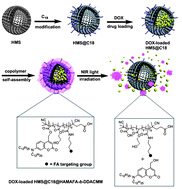Coumarin-containing photo-responsive nanocomposites for NIR light-triggered controlled drug release via a two-photon process†
Abstract
A new multifunctional nanovehicle for tumor therapy and cell imaging was fabricated by coating NIR light-responsive polymers (HAMAFA-b-DDACMM) onto the surface of octadecyltrimethoxysilane (C18)-modified hollow mesoporous silica nanoparticles (HMS@C18) via self-assembly. First, the targeting NIR light-responsive block copolymer was synthesized by the RAFT living polymerization of [7-(didodecylamino) coumarin-4-yl] methyl methacrylate with hydroxyethylacrylate and N-(3-aminopropyl) methacrylamide hydrochloride and then grafted with folic acid (FA). The copolymers could be disrupted by excitation by a femtosecond NIR light laser (800 nm) via a two-photon absorption process due to the high two-photon absorption cross-section of the coumarin moiety. In order to enhance the drug loading capacity and biological stability of the nanovehicle, HMS nanoparticles modified by hydrophobic octadecyl chains were selected as the “core”, which had a considerable drug loading efficiency of more than 70%. Then the core–shell nanocomposites (HMS@C18@HAMAFA-b-DDACMM) were obtained by coating the amphiphilic copolymers onto the core via self-assembly. Under excitation by NIR light at 800 nm, the pre-loaded drugs could be released from the nanocomposites due to the degradation of the light-responsive copolymers and the release efficiency was correlated with the irradiation time and light power. The in vitro experiments indicated that the nanocomposites were easily targeted into the tumor cells that over-expressed folic acid receptor (FR(+)) such as KB cells by endocytosis. Furthermore, the copolymer itself had strong fluorescence, which could be used to track the process of drug delivery.


 Please wait while we load your content...
Please wait while we load your content...